Pyramids In The Pacific

The Unwritten History Of Australia
Chapter 32
|
Pacific Atlantis The Lost Land of Wainga-roa |
"For thus saith the Lord God:
I shall make thee a desolate city.
Like the cities that are not inhabited.
I shall bring the deep upon you
and great water shall cover thee"
Ezekiel 27: v1.
|
Chapter
32 Images
|
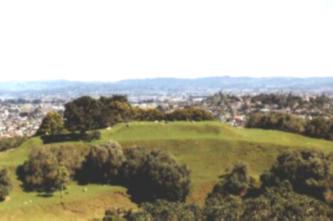
|
Two Terraced Structure New Zealand
Photo by Rex Gilroy
Ancient traditions from island Melanesia and Polynesia to the Americas, speak of a lost land shelf or continental mass, which formerly covered a considerable expanse of the western and central Pacific region and of which only islands now remain. As mentioned in the two previous chapters, I have argued that this great landmass extended south to include New Zealand {then a single landmass} and that this landmass was joined to New Guinea/Australia and the great landbridge extending to mainland Asia.
To the Maoris of New Zealand it was the "Lost Land of Wainga-roa". It had, they believed extended from present day Cape Reinga and had been submerged by the sea, a disaster in which whole tribes of people perished. These were the Ngati-Kaiperu, also known as the Uru, whom other legends say, were a white-skinned people who built in stone and whose ruined culture-centres now lie submerged beneath the waters of the Pacific islands. Hotu Matua, the great blond-haired, fair skinned culture hero of Easter Island, is said to to have arrived there with with his followers, in a great "feathered boat" {ie a vessel with sails}, from a sunken land to the west. Hotu Matua subsequently introduced the art of stone building to the island.
Traditions of the so-called biblical "great Flood" are but world-wide, race memories of the final stages of the great ice-age, when the melting ice-caps caused the oceans to rise, flooding all low-lying land. Both the Fijians and Tongans, as already mentioned more than once in this book, preserve traditions of this great sunken land, and say that, there was a time when their ancestors used to "walk to visit each other, rather than sail, as they do now".
|
Pyramids
in the Pacific Images Ch 32
|
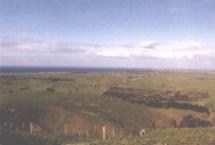
|
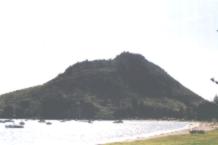
|
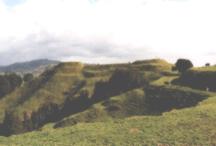
|
|
Bay of Plenty |
Mount Maunganui |
Papamoapa New Zealand |
In the "Codex Chimalpopoca", one of the sacred books of the Toltecs, written between 200 BC-900 AD, there is reference to a "rain of fire", being symbolic of a great disaster, in this case, the "great flood".
"Now, this was in the year Ce Tecpatl, One
Flint, it was the day, in which men were lost
and destroyed in a rain of fire, they were
transformed into goslings; the sun itself was
on fire, and everything, together with the houses
was consumed {ie Flooded}'.
The Australian Aborigines had the giant Bullfrog-Tidalik the flood maker-who caused a flood, and it is an obvious race-memory of the flooding that occured in Australia at the close of the last great ice-age. Similarly, the Iroquois Indians of the eastern United States, posses the tradition that a giant frog, the emblem of cold and water, had to be slain to release the waters of the earth which he had consumed. The American Indians, from the tribes of California to the old megalithic cultures of Central America, all possessed myths and legends of a great land, far across the Pacific which had been submerged in the ocean depths.
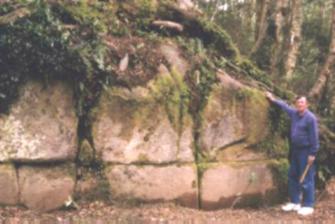
|
Rex at the Kaimanawa Wall New Zealand